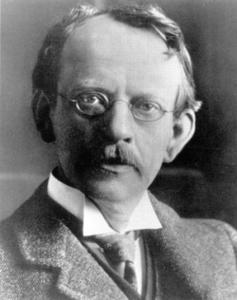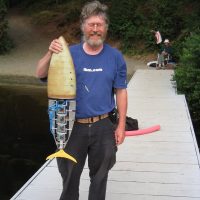Peer Review process in science and how it can thwart innovation:
I am part of a graduate study group in Materials Science at the University of Victoria every Friday. It’s an amazing group of inventors. Rodney Herring is the professor of the group and is the guy who led the project which created the world’s most powerful electron microscope at UVic.
In the process of working with the group over the last decade a number of interesting problems within the science community have come to light. All the professors and graduate students have observed the hazards of “peer review” within a creative group of scientists. Peer review holds back revolutionary ideas.
I will give just three examples, although I could give hundreds.
Example One
Rodney Herring had the equipment to tell coherent light from incoherent light. Coherent light is one in which all the photons are in phase such as from a laser beam.
Rodney had read for years in textbooks that fluorescing light such as produced when UV or black light hits something that glows green or some other colour produces non-coherent light. Textbooks from 1960 onwards all said that fluorescing light is never coherent. So he shone a UV light onto something that fluoresced and measured the light for coherence. Much to his surprise the light was coherent!
So he wrote up a paper in which he tested a number of materials fluorescing under UV light and all were coherent sources. He tried to publish it over 10 years and it always got rejected by “peer reviewers” and he could not publish. He got comments such as “everyone knows this is not true!”.
This is a typical problem that has happened in science always. People speak highly of “peer review” but it is driven by the human property of belief. Beliefs are difficult for people to drop.
Example Two
Einstein had trouble publishing his first few papers because peer reviewers rejected them for transgressing the standards of Isaac Newton!
It is an interesting human phenomenon that holds back science. Anthropologists have written about the phenomenon of belief holding back science.
Example Three
J. J. Thompson, discoverer of the electron, found radioactivity in well water in 1903. Within a year scientists throughout the world discovered that all famous healing hot springs such as Lourdes in France or Bath in the UK were mildly naturally radioactive.
(J.J. Thompson is shown in the picture for this article.)
Many in the Friday graduate study group at UVic have come to accept Radiation Hormesis, or the beneficial effects of low dose nuclear radiation. There is a vast array of scientific experiements that back up the phenomenon which has been observed for thousands of years. Peer Pressure however had held back this research. Almost everyone believes there is a danger because of this. Where does this belief come from?
In about 1961 a number of well meaning scientists, including a nobel prize winning scientist called Herman Muller were part of the “Ban the Bomb Movement” which sought to create fear of radiation to stop the proliferation of the Atomic and Hyrdogen bombs.
Herman Muller’s research was discovered about 7 years ago by Dr. Edward Calabrese and he found that Mullers research had proven that low dose nuclear radiation had a number of distinct advantages for living things!
Low dose radiation boosts immunity to cancer and infectious disease. It also increased the efficiency of reproduction. Muller hid his work in 1946 because he was part of the new “Ban the Bomb” movement in and felt it was better to scare the public about radiation rather than publish anything about beneficial effects.
Other scientists came on board and in 1961 approximately a widespread movement of scientists were led to believe that low dose natural nuclear radiation was hazardous.
In our graduate study group at UVic, several members of the group wear uranium glass beads to boost immunity because of reading the research on Radiation Hormesis, or the postive effects of nuclear radiation.
The main scientist who re-started “radiation hormesis” research was Dr. T. D. Luckey who wrote the book with this name in 1982 based on all the research on low dose radiation from 1880 to 1980. He had the help of a dozen university students over 10 years to review everything that was done in this field for 100 years. He found 40% of the papers observed biological advantages and that not one paper showed a danger.
When he published his huge 1000 page book in 1982 he was criticised by the administration of the University of Missouri for publishing such an outrageous book. They wanted to fire him. He told them he would make it easy. “If you guys find a few great papers proving I am wrong I will quit. I give you one month.” They replied there are thousands of papers proving it!
And so the scientists at the university looked and looked and at the end of a month asked for an extension because they could find no proof of the danger!
T. Don Luckey worked for an additional decade at that university. He has received a knighthood from Germany and Japan (Samurai) for his work but remains almost unknown in North America.
I had the honour of being an email friend for the last 3 years of his life. He used low dose radiation to boost his own health and finally died in his 90s.
Healing hot springs are universally accepted as being sources for healing in most European and Asian countries. They have been in use for about 7000 years. How do they work? Well it turns out that each and every famous healing hot spring is mildly radioactive because of the water’s close contact deep under the earth where uranium exists almost everywhere on earth.
To this day Germany, Austria, the Czech Republic and almost every European country supports the use of natural hot springs to treat arthritis and a number of diseases. In Germany and Austria you can get a prescription for a holiday at a hot spring for various diseases!
I wrote a website and collected papers from scientists worldwide who submitted research to support “radiation hormesis” or the positive health effects of low dose nuclear radiation.
Here it is …
Its a vast site that transgresses what everyone believes about radation but I recommend that you look at several parts of the site first …
1/ The radio broadcast by Canada’s Bob McDonald of “Quirks and Quarks” on Radiation Hormesis.
2/ Use the menu and look at the Research Library. The first paper is published in a Canadian Oncology journal and suggests that its time we started to use ultra low dose nuclear radiation to treat cancer and not high dose like we currently use.
Browse the other papers …
Then go back to the beginning and check out the site.
This whole field of Radiation Hormesis is a good example of the harm that “Peer Review” can do by holding back the progress of new ideas.
Much human suffering could have been prevented and many new technologies could have been created if “peer review” was not based on belief.
Writers Profile
Ian Faulkner of Vancouver Island is known as a “crazy eccentric inventor” by his friends and neighbors because he does not own a car, has supported his family for 40 years by inventing electronic products, and has dozens of unusual hobbies. He is a Sufi, Buddhist, Christian, and Taoist spiritual explorer using meditation, psychedelics, bodywork, and ecstatic dance. Ian’s professional skills include electronic engineering, Trager massage, intimacy education, web journalism, and scientific research for product development. He has many hobbies including beekeeping, alternative medicine, photography, rock collecting, astronomy, mushroom study, jewelry making, dancing, yoga, and meditation. He is active on Facebook and maintains many websites on health issues.












Read 0 comments and reply